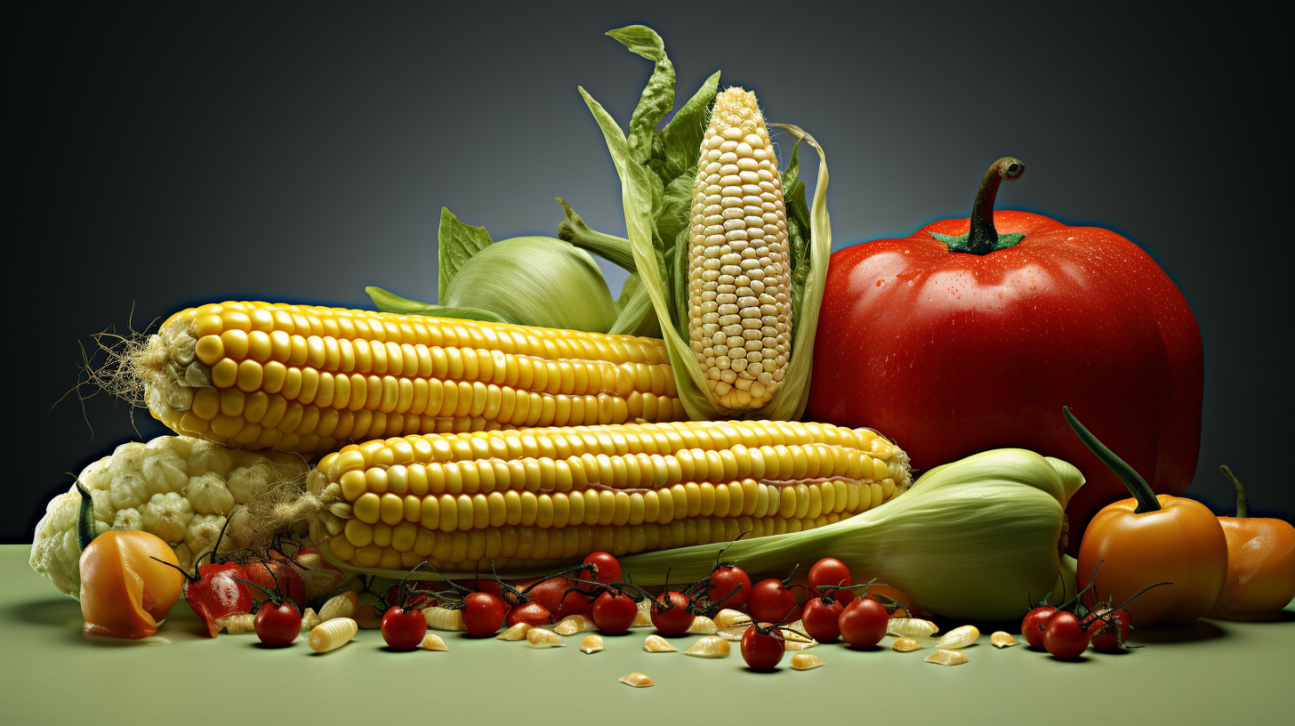Genetically modified (GM) foods have been around since the 1990s and are becoming increasingly common in our food supply.
While proponents point to the agricultural and nutritional benefits of GM crops, concerns remain about their safety and environmental impact.
What are GMO Foods?
Genetically modified (GM) foods have had their DNA altered through genetic engineering techniques.
This involves inserting desired genes from one organism into another to give it new properties, like pest resistance or increased nutrients.
Some common GM food sources are soybean, corn, canola, sugar beets, and papaya. GM crops tend to fall into two categories:
- Herbicide tolerant – engineered to be unaffected by certain herbicides, allowing farmers to use them without harming the crop.
- Pest resistant – contain genes from the bacteria Bacillus thuringiensis (Bt) that are toxic to certain insect pests. This reduces the need for pesticide applications.
GM foods were first approved for human consumption in the 1990s starting with tomatoes, corn, potatoes, and soybeans.
Today, between 75-80% of processed foods in the U.S. contain GM ingredients.
Benefits of GMO Foods
Proponents argue GM foods can provide a number of benefits:
- Increased crop yields and food security – GM crops tend to have higher yields due to herbicide and pest resistance. This could help feed the world’s growing population.
- Improved nutritional properties – Genes can be added to improve nutritional quality. Examples include golden rice with increased vitamin A and iron/vitamin-fortified crops.
- Reduced pesticide use – Pest resistant GM crops require less pesticide application, which benefits the environment. Herbicide resistant crops also facilitate no-till farming, reducing soil erosion.
- Resistance to disease and harsh conditions – Genes can be engineered into crops to make them resistant to viruses, extreme weather, and poor soil – helping stabilize food supply.
- Longer shelf life – GM tomatoes, for instance, have been modified for longer shelf life. This reduces food waste.
- Medical applications – Edible vaccines and other medicinal foods are being developed through genetic engineering. For example, bananas modified to produce hepatitis B vaccine.
Concerns About GMO Foods
On the other hand, GM foods have received criticism on a number of fronts:
- Human health effects – Critics argue GM foods may introduce new allergens or toxins. Some fear antibiotic resistant genes used in engineering may transfer to gut bacteria. However, no direct negative health effects have been reported despite two decades of use.
- Environmental impact – Pest resistant crops could encourage “super bug” insects resistant to Bt toxin. Herbicide resistant crops may also increase herbicide resistant weeds. There are also concerns about the impact on non-target species like bees and butterflies.
- Lack of long-term research – Critics argue there has not been enough long-term study to prove GM foods are safe for human consumption. Most safety studies have lasted 90 days or less. However, some longer term studies have now been done and found no adverse effects.
- Corporate control of food system – Anti-GMO activists express concerns about large corporations like Monsanto controlling much of the seed stock and food system.
- Labeling and traceability – Surveys show a majority of Americans want GM foods labeled. There are concerns traceability protocols are not stringent enough to track health impacts. The EU has implemented tracing regulations for GM foods.
- Ethics and tampering with nature – Some view GM foods as humans “playing God” and tampering with the natural order in an unethical way. This resonates with many environmentalists and consumers.
How GMO Foods Are Regulated
The U.S. Food and Drug Administration, Environmental Protection Agency, and Department of Agriculture all share oversight of GM foods.
GM producers must adhere to strict regulations that include:
- Extensive food safety testing – GM foods undergo rigorous testing to ensure they are safe for consumption and not substantially different from traditional counterparts.
- FDA review of safety data – Companies submit extensive food safety test data to the FDA for each GM food, which is reviewed for potential toxicity or allergenicity risks before commercial release.
- EPA review of environmental safety – The EPA analyzes environmental impact data submitted by companies to ensure GM crops will not harm other plants or wildlife.
- Post-market surveillance – The FDA monitors the marketplace for any indication of health consequences once a GM food is available to consumers.
- Mandatory labeling – Specific GM ingredients like high oleic oils must be labeled, but foods made with GM crops do not need to be.
- Segregation practices – GM seeds and products are kept separate from conventional ones during transport and processing to prevent commingling.
Despite this regulation, critics argue the FDA’s voluntary consultation process does not go far enough to adequately assess long-term safety.
Many advocate for mandatory pre-market safety assessments and labeling of GMOs similar to the EU’s approach.
Public Debate of GMO Foods: Support vs. Criticism

The polarization surrounding GM foods has intensified in recent years as their use has expanded.
Those in favor argue GM food is perfectly safe based on current science, and has the potential to feed the world sustainably.
However, critics contend not enough is known about the long-term effects to assure safety, and prefer a precautionary approach.
They advocate for more rigorous, mandatory testing, and transparent labeling of GM ingredients.
Surveys show the majority of Americans are skeptical of GM foods and want them labeled.
The massive agricultural potential of genetic engineering technology means the GM debate is sure to continue as new food applications emerge.
More independent, long-term safety studies may be key to building public trust in the future.
However, GM foods seem poised to become an increasingly integral part of the global food system.
Their regulation will continue to evolve and require close monitoring of any potential health and environmental impacts.
In summary, GM foods hold promise in many areas but also raise legitimate safety and environmental concerns.
More research is still needed to elucidate the long-term effects of genetic engineering on human health.
In the meantime, improving transparency through labeling and traceability protocols may help consumers make more informed choices.
The public conversation will be central to shaping the future role of biotechnology in our food system.
References
- Study: Genetically modified foods: safety, risks, and public concerns
- Authors: A.S. Bawa & K.R. Anilakumar (2013)







